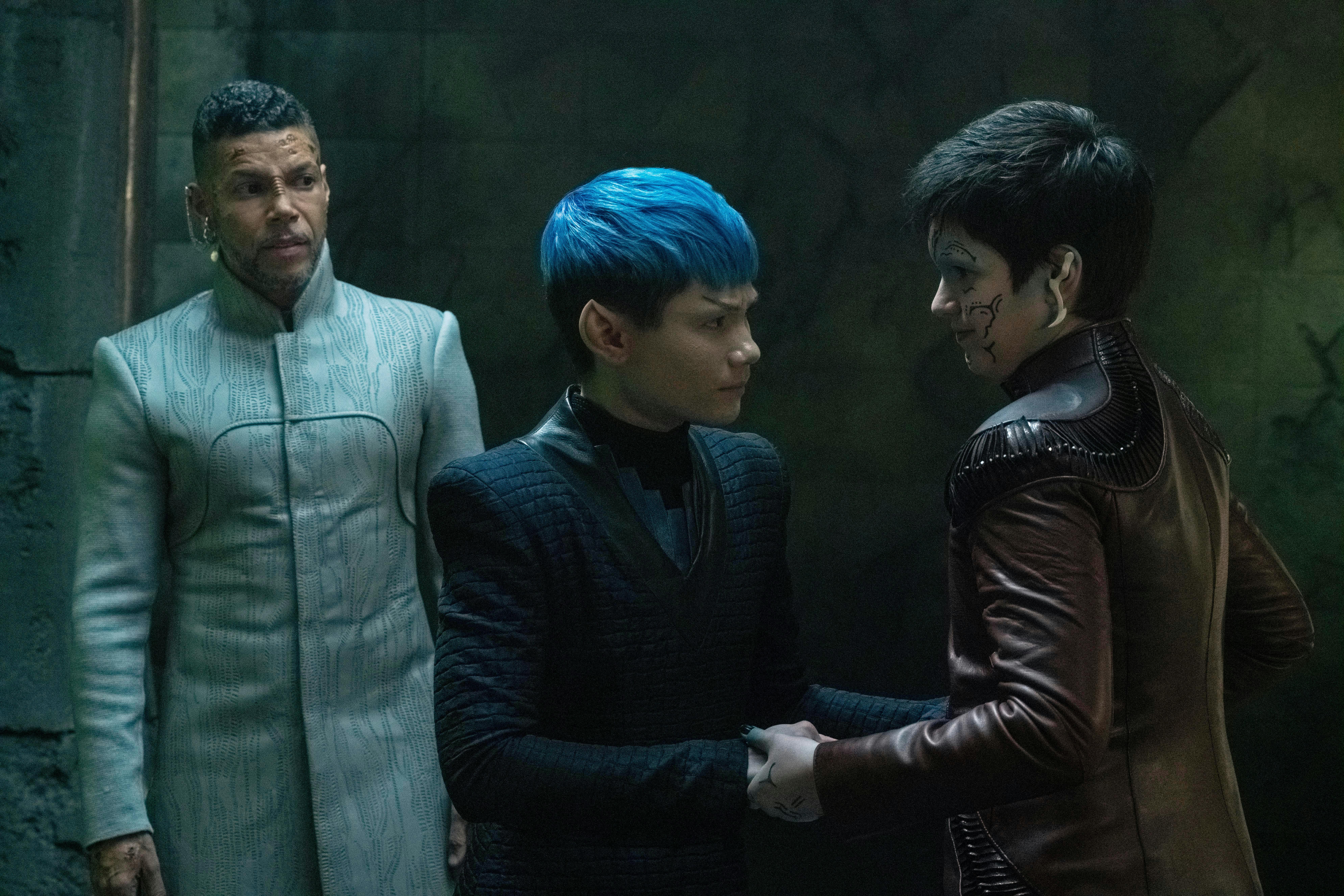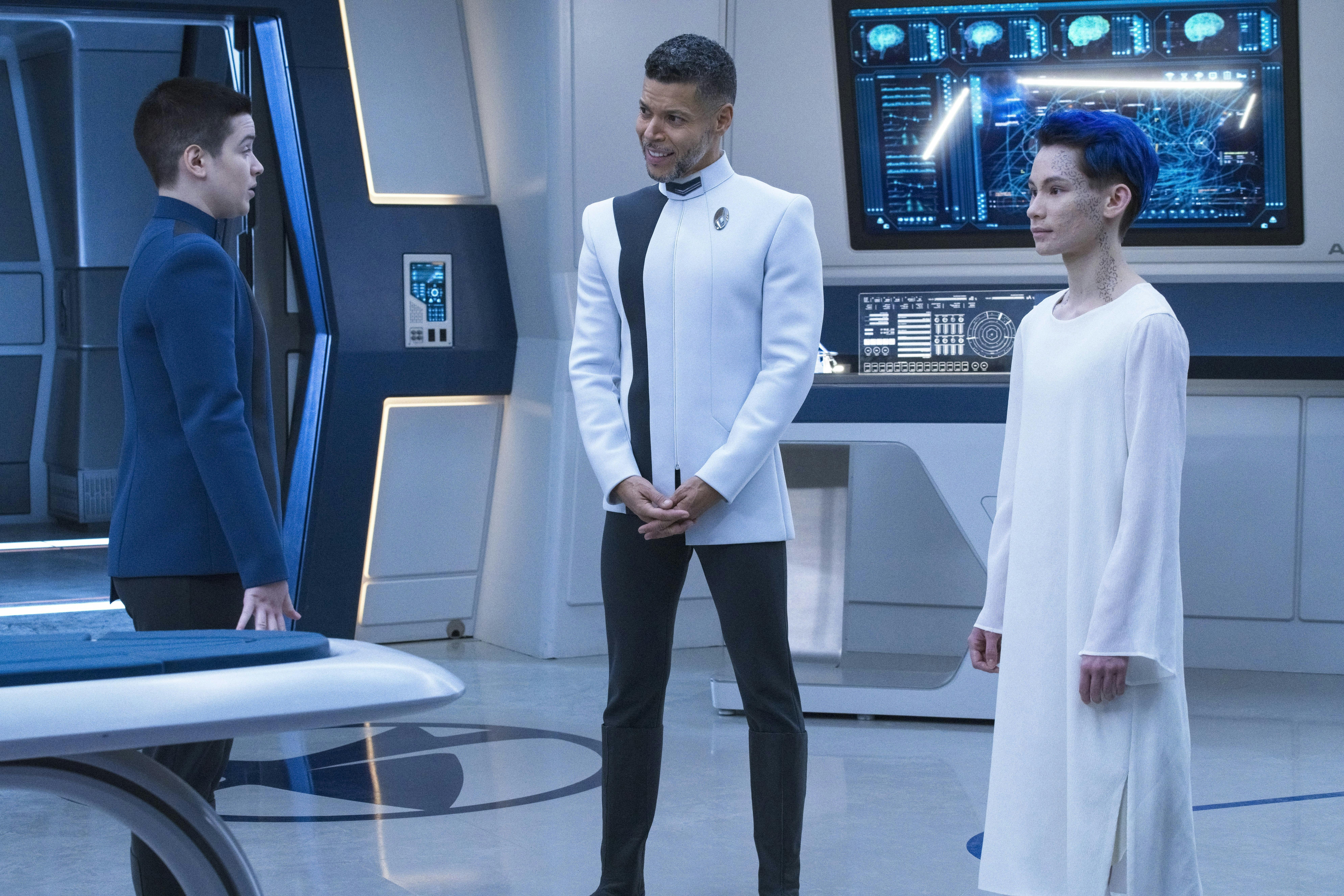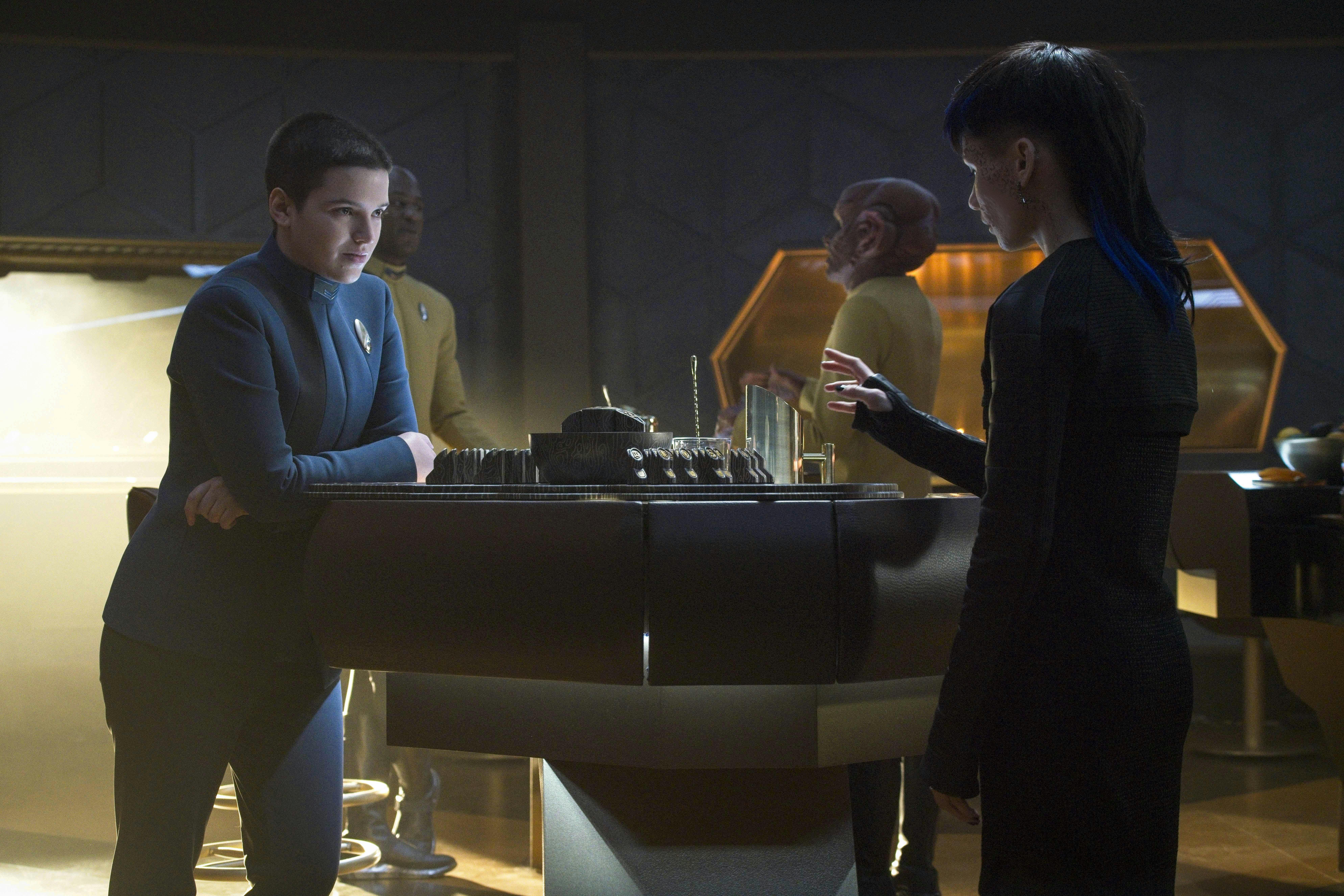Published Apr 20, 2023
How Star Trek: Discovery Helped Shine a Light on Trans Narratives in Sci-Fi
Gray Tal boldly goes where no trans character has gone before.

StarTrek.com
Today is Ian Alexander's birthday, and it’s the perfect opportunity to celebrate Star Trek: Discovery’s Gray Tal!
Played by Alexander, Gray made his first appearance in the third season episode, “Forget Me Not," but he didn’t exactly make his first full appearance until Season 4. This is just one of the ways that Gray’s narrative arc on Discovery echoes the lived experiences of trans people like myself.
While Gray may not be the first time trans people have been able to see some aspect of ourselves reflected in Star Trek, he represents a significant step forward in depicting trans characters for the franchise.
Gray Tal and the Synthetic Golem
Gray was first introduced in the episode “Forget Me Not,” in which Adira (Blu del Barrio) and Captain Michael Burnham (Sonequa Martin-Green) travel to the Trill homeworld in order to restore the memories of the Tal symbiote. After this mission had been accomplished, Gray began to appear and interact with Adira. However, they were the only one who could see Gray.
In the third season finale, “That Hope is You, Part 2,” Adira beams aboard the active holodeck of the K.S.F. Khi’eth. Because of the nature of the holodeck program, they appear as a Xahean rather than a human. Remarkably, the hologram is also able to detect the presence of Gray alongside Adira, and while he appears as a Vulcan instead of a Trill, this limited manifestation gives Gray a taste of interaction with fellow crewmembers Saru and Dr. Hugh Culber. After that episode, the hologram is deactivated, and Gray once again becomes visible only to Adira. But before that happens, Culber promises Gray that they’ll find a way to make him visible to everyone.

StarTrek.com
Dr. Culber finally follows through with his promise in the fourth season. In the episode “Anomaly,” the synthetic golem technology we saw Dr. Altan Inigo Soong developing in the first season of Star Trek: Picard is applied to provide a synthetic body into which the Tal symbiote may be placed. Over the course of the next episode, “Choose to Live,” a Trill Guardian performed a special zhian’tara that allowed the Tal symbiote to bond with the synth body. While these science fiction aspects of Gray’s story are fertile ground for exploring trans-coded stories, Gray is textually confirmed to be trans.
For trans Star Trek fans of a certain age, such as myself, Jadzia Dax on Star Trek: Deep Space Nine was something of a stand-in for trans rep before textual trans rep existed. Because of the Dax symbiote, Jadzia remembered a “previous life,” that of Curzon Dax. Further, her commanding officer, Commander Benjamin Sisko, had been close with Curzon. For this reason, the fact that Jadzia had “transitioned” not just from between hosts but also into a different gender was frequently foregrounded.
It’s evident why trans readings of the character became so popular, particularly when you recall scenes like the one in the DS9 Season 2 episode “Blood Oath,” in which Klingon warrior Kor reunites with Dax and accepts his old friend’s new name without hesitation. And in scenes that I found especially affecting as a queer, trans woman, both Jadzia and the subsequent host of the symbiote, Ezri Dax, shared on-screen kisses with other women (even if Ezri’s was undertaken by her Mirror Universe counterpart).
But in “Anomaly,” Discovery distinguished itself by confirming that Gray being trans was distinct from both the fact that he is Trill and that he has a synth body. As Dr. Culber prepares Gray’s synth body in that episode, the topic of a mole on Gray’s hand is brought up. Gray notes that while it used to bother him when he was young, he was too focused on his transition to deal with it. (While the DS9 episode “Profit and Lace” may not be the best example of transgender representation, it does confirm that gender transition is as accessible and technologically advanced as any other medical procedure in the 24th Century).
While Gray’s “transition” into the synth body does offer plenty of thematic parallels to undergoing gender transition, dialogue clarifies that neither the synth body nor the fact that he is Trill is a stand-in for Gray being trans — this is simply another distinct facet of his character.
Visible Spectrum

StarTrek.com
While I was not literally invisible, I deeply relate to Gray’s narrative arc. Before I came out as a trans woman, I often felt as though no one could see me; in hindsight, for obvious reasons, I was hiding my authentic self from everyone around me. This not only hindered my ability to connect with others, whether they were already close to me or were people I had never met before. It also had a devastating effect on my writing; without being honest about who I was, my words were consistently little more than hollow echoes of what I thought the person I was supposed to be would say.
When I came out to my spouse, though no one else, my experiences could be compared to Gray’s situation after “Forget Me Not,” where Adira can perceive him, but he is invisible to everyone else. While my partner’s support was essential, just like Gray, I soon realized that I wasn’t satisfied with only being visible to one person.
Once I began to engage with the world as my authentic self, all that changed — just like Gray is suddenly able to be perceived by his crewmates thanks to the fact that the holographic environment can detect his presence in “That Hope Is You, Part 2,” coming out of the closet finally allowed me to connect with my writing. Suddenly, I was actually being seen. This led to the publication of several articles I’d written, followed by the opportunity to interview for a position with Heidi MacDonald, the editor-in-chief of the long-running blog Comics Beat.
During the interview, Heidi explained to me that she was assembling her “Next Generation crew.” As a long-time Trekkie, I immediately connected to the reference and understood the intentions she conveyed. As we spoke more, she told me that my perspective was important and needed to be heard.
One of the most valuable lessons I have learned from my transition is that it helps others if you speak from an authentic place. It makes me think of Gray’s role in “Stormy Weather.” Having recovered from the golem procedure, Gray now has a body and can fully interact with the rest of the crew, including Zora, the developing sentient personality of Discovery’s computer. Over the course of the episode, Gray helps Zora by sharing a Trill method that helps with sensory confusion when assimilating into a new body and helps calm him in uncertain situations. Zora then applies this knowledge at a key moment, enabling her to save the crew.
While the knowledge Gray shares with Zora may not be directly related to his trans experience, he can only share it with her because he has undertaken the golem transition procedure, enabling him to truly be seen and communicate with those around him. It’s a perfect example of how Discovery’s crew is more than willing to go out of the way to address the unique needs of one crew member can affect the needs of all the crew, and how that investment can prove invaluable for every crew member on board.
We Enter the Future Together

StarTrek.com
In the 1998 Star Trek: The Next Generation/X-Men crossover novel Planet X by Michael Jan Friedman, several of the Marvel Comics mutants travel to the 24th Century and end up aboard the Enterprise-D. In one particularly affecting line, Ororo Munroe addresses Jean-Luc Picard.
“Being accepted for what we are… it has always been a dream to us, a goal we could hold up but never realistically hope to attain,” Storm tells Picard. “I hope you understand the wonder of a society that judges each being on [their] merits … This is the true miracle of your Federation, Captain. This is your greatest achievement.”
Having a visible trans character like Gray included in the cast of Discovery sends an important message — trans people are an integral part of the future utopia depicted by Star Trek. In an era where being trans is met with prejudice, Discovery gives us hope for a world where we can be assured that we will be accepted for who we are. Furthermore, the value of seeing trans characters who are empathetically depicted and whose perspective is given value in a franchise with the staggering cultural impact Star Trek possesses cannot be understated.
In an interview conducted for Forbes, Dawn Ennis asked Discovery showrunner Michelle Paradise to consider including a trans woman character (noting correctly that we’d be pleased to see her in any spinoff). Hopefully, it won’t be long before we’re seeing more trans characters follow where Gray has boldly gone before — into the visible galaxy of Star Trek!
This article was originally published on March 31, 2022.
Avery Kaplan (she/her) is the Features Editor at Comics Beat. You can also find her writing on NeoText, Geek Girl Authority, Comics Bookcase, and in many issues of the Eisner Award-winning PanelxPanel. She is the co-host of the Matrix 404 podcast and the Comm Officer at Prism Comics. Find her on Twitter @averykaplan6
Star Trek: Discovery Seasons 1-4 are currently streaming exclusively on Paramount+ in the U.S., the U.K., Switzerland, South Korea, Latin America, Germany, France, Italy, Australia, and Austria. Seasons 2 and 3 are also available on the Pluto TV Star Trek channel in Switzerland, Germany, and Austria. In Canada, it airs on Bell Media's CTV Sci-Fi Channel and streams on Crave. Star Trek: Discovery is distributed by Paramount Global Content Distribution.
Stay tuned to StarTrek.com for more details! And be sure to follow @StarTrek on Facebook, Twitter, and Instagram.
